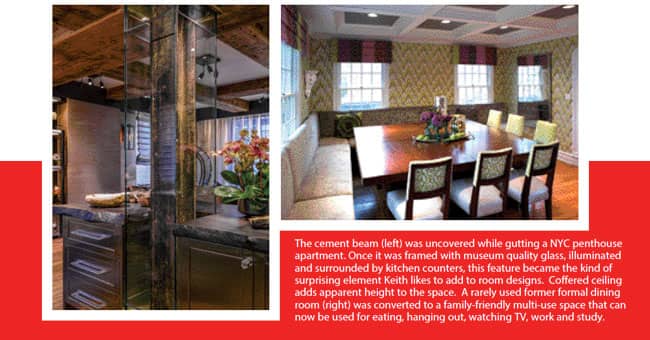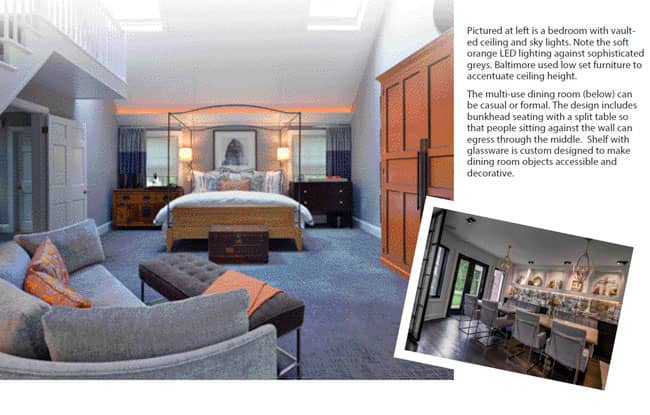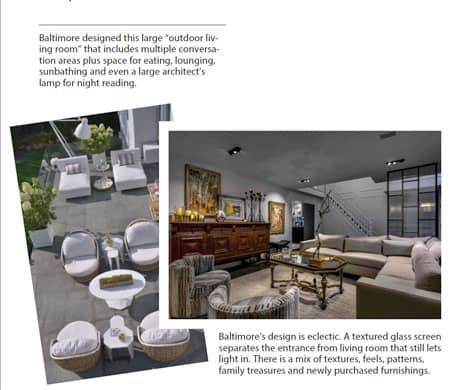
Interior designer and furnishings retailer Keith Baltimore shares his thoughts about nurturing and romancing the design and retail experience.
This month Furniture World was pleased to interview designer Keith Baltimore. Keith established the Baltimore Design Group, Port Washington, NY, more than 25 years ago. This award-winning firm has designed both luxury residential and commercial spaces around the world. Keith has a media presence in print and video, with his designs featured in Traditional Home, NY Cottages & Gardens, LI Pulse, Newsday, Luxury Living, DecoratorsBest.com, and NBC LX-TV Open House. With a pay-it-forward philosophy, Mr. Baltimore supports numerous philanthropies, as well as donating an annual arts and design scholarship.
Early Inspirations
Furniture World asked Keith to describe how he got his start in design.
“I’m a native New Yorker and have been fascinated by design my entire life. As a child, I rearranged furniture, but after starting to move the electrical and plumbing at age 10, my parents were like, ‘You've got to stop!’
“Because I was good at math and science, I started college as a pre-med student. Within four months I switched over to fine arts, and then transferred to the University of Maryland as an interior design major and architecture minor.
“After graduation, thinking myself to be the reincarnation of Frank Lloyd Wright, I returned to New York as an employee at a very large interior design firm. That lasted for about an hour! The experience taught me that I couldn’t be a cog in a corporate wheel. I transitioned to a small interior design firm, a one-man operation. There I assisted with drafting and designing, doing day-to-day invoicing, and figuring out how the design business works.
|
"Most retail furniture
store situations present furnishings that fit the bill. It’s a this works – that doesn't – sales
philosophy." |
“Then, as fate would have it, I accompanied my uncle to look for a sofa. We walked into Contemporary Living, a retail store in Brooklyn. We walked around the store and I was telling my uncle, ‘This is the wrong way, the wrong dimension, the wrong color. We might want to take the back off of here. Can you recess the base?’
“The owner of the firm had been watching us and came up and asked me, ‘Oh, who are you?’ Then he hired me on the spot! Less than two years later I was recruited by Harrison Interiors in Cedarhurst before opening up my own firm, a small retail store, also in Cedarhurst. That was 30 years ago.”

Baltimore Design Center
Question: Opening your own store was a big undertaking. What was the impetus for that?
“I have been influenced by the times, by pop culture, and by my clients’ culture. I find beauty in everything. My talent is that I notice everything, take it in, and then synthesize it into design.
“Retail is much like a think-tank. At its best, it’s an experiment in mixing styles and color, a laboratory of design. What happens if we paint that wall chartreuse? What if we force that color story in the showroom? Will people like that? Will it increase sales? How will shoppers react?
“Here’s an interesting design story: back in 2001, Baltimore Design Center was filled with taupes, whites, and greys – very muted and very somber. Soon after 9/11, I had all the walls painted in bright tones, hot pink, orange, and fuchsia, to liven things up and make the showroom feel happier. The furniture, accessories, and art were, of course, the same as before.
“When our customers walked through that showroom, they had emotional reactions. While I can’t quantify the effect on sales, people walked in, and their faces reflected joy, interest, fun, and even temptation!
“Being a great retailer is not just about selling furniture, accessories or art. It involves working to invoke a visceral reaction, an emotion in the people who enter.”
|
"Being a great retailer is not just about selling furniture, accessories or art. It involves working to invoke a visceral reaction, an emotion in the people who enter." |
A Taste For Everything
Question: How do you differentiate Baltimore Design Center from the general retail landscape?
“Baltimore Design Center is not a typical retailer because the products we sell are so eclectic. We have antiques, mixed with mid-century modern, mixed with cold modern. There’s a taste for everything, a kind of smorgasbord of furniture. We know we can't be everything for everybody, but we can let people see things combined in a way that they don't normally see in an 8,000 square foot store.
"We stock and have custom order, plus we carry all the big lines, including Lee, Bernhardt, Century, Theodore Alexander, Old Biscayne, Palecek, and many more. We also have lots of accessories by many different artists.”
Romancing the Retail Experience

“It’s a very interesting time because the experience of retail is a dying art. With the growth of online furniture sales, furniture-store traffic is not as good as it once was. My job as a retailer is to make our shopping experience better. That includes the smell, the sound, the service, the whole retail ambiance, every day a playlist all based on design.
“The romancing of the retail experience has to be nurtured. I don't see as much attention given to that in most other retail venues. Don’t get me wrong, there are certain retailers who do know that to keep clients, they have to craft an experience that creates a gut reaction, and at the same time generates the comfort to purchase.”
Examining Sales Philosophy
Question: When you walk into an average retail store or check out industry websites, what do you typically think about their offerings?
“Most retail furniture store situations present furnishings that fit the bill. It’s a ‘this works – that doesn't’ sales philosophy. Online, consumers find a piece that comes in the color they want. It’s shipped to their house. If they don't like it, they ship it back. It’s a commerce experience. I couldn't comment on the whole overall scheme of retail, but 90 percent of the time I'm a little turned off.
“Back when Levitz was in business, I was called in to review their presentations. Their sales floor looked like a sea of matching furniture sets. Customers could see the first scene, which was modern, the next, southwest, the next, Victorian. It presented like a slide show of time periods, and it was unappealing in terms of experience.
|
"My job as a retailer is to make our shopping experience better. That includes the smell, the sound, the service, the whole retail ambiance." |
“I suggested they take all of this, put it in a blender and throw it all over the floor so that shoppers could see mixes of things they normally wouldn't mix. When things are too matched, too cookie-cutter, it tends to be a little boring and visually uninteresting.
Asking the WHY Question
“I understand that from a big retail perspective, there’s a focus on buying sets, on gross margin, and inventory control. But even for these retailers, a lot can be gained by not positioning sets where everything is the same height, where all the backs and colors are the same. For a more creative approach, asking the question ‘Why?’ is a good place to start.
“Look at why you mix a curved back sofa with a low chair. Think about how the eye moves over your design choices, and why. Will someone want to stop there and just sit? What are the reasons why they would buy that sofa? Is it comfort? Sure, it is, but at a higher level, what are the relationships between that sofa and chair, the rug and the coffee table? It’s a dialogue that can be discovered by talented people who have a design background and know how to listen.
The Importance of Listening
Question: Tell us about your design clients and your process.
“Most of the design business comes through our reputation. Our design clients know that we listen, which is the most important aspect. It’s not about the latest trends, it’s about what makes our clients comfortable, makes them smile, makes them tick.
“Many of our design clients are homeowners from the Hamptons, the Gold Coast of Long Island, Manhattan, Florida, and New Jersey. People come to our store for design services based on our approach to design, which is anthropological. They know that at the end of the day the design of their rooms was created exclusively for them.
“The result is that all my designs are unique because my clients’ lives and style preferences are also unique. It’s important for me to interpret their needs to create cohesive, functional designs for their homes. The first challenge for me and my staff is to facilitate that design by doing research, then synthesize that information, explain to clients what’s available on the market, and let them know what’s possible.”
Anthropology and Design
Question: Please expand on the idea of an anthropological approach to design.
“Anthropology is the study of humans. As I mentioned before, listening is important. Clients can be a bit closed off at the beginning, but it’s important to get information. Otherwise the process won’t work well for them. So, I am very inquisitive and very specific.
“I was classically trained, creating formal, traditional, interior design for clients as well as modern or post-modern work. As an interior designer my job is to understand differing schools of thought. It would be egocentric to force my own ideas on a client. My job is to interpret what clients want and then make something good happen – maybe push the envelope, and show them visuals that might challenge them. As an interior designer, I see myself as both an educator and an anthropologist.

"For a more creative approach,
asking the question ‘Why?’ is a good place to start."
“When I travel, for example, I like to go to learn about people by visiting the grocery store. There are some customers who read every label; and then there are those who just throw everything into their cart and check out to get to the next activity. Then there are people who enjoy the shopping and are interested in the smells and textures around them – they smell the lemons. You can tell a lot about the culture by seeing how differently people shop.”
It's an Amazon World
Question: Do your observations inform how you interact with clients?
“It may not change the way I interact with people, but I think it's been useful in understanding how clients are so different. I can better understand the impetuous customers who says, ‘Alright, just set it up, I love it.’ Or, the ‘I don't know where I'm gonna end up putting it, but I'll find the spot,’ customer.
“We live in an Amazon world. Many people aren't going to the grocery store anymore. But there are still some people who want to smell that lemon. So, it depends on the person. Baltimore Design Center is a mom and pop operation, and the older generation definitely shops the showroom. Millennials aren't doing that. They might run in for a minute and see if they can pick something up; or they're online looking at what they can get, how they can get it quickly, and at the right price.”
Anthropology and Retail
Question: Does your anthropological approach translate to Baltimore Design Center, a retail environment?
“It’s exactly the same design philosophy – it's all about the client. Because of our reputation, people visiting the store come in looking for a vibe. They hope to get an experience that will inform how they will furnish their home to create something special. Certainly, if they want to just buy a sofa or sectional, they can do that, but it’s not usually the type of store traffic we get.
“More generally we see people who are thinking about doing their kitchen and living room but don't know where to start. If it becomes a project, we can make plans, and take care of everything from that point on.
“People also come to the store to find accessories and art pieces, the things they would not be able to find anywhere else. The store is unique, including items selected to be thought-provoking, not typical home goods, a curated visual.
“People come to me for creativity and to push the envelope within their genre. They want their rooms to be current, even if the style is traditional. We don’t just make pretty rooms, or place a chair in a certain spot because it looks like a chair should go there. For every trim, every build, there has to be a reason why. If we make a night table high or low, its comes back to the functional needs of the person who will live there. It is an explicit story. For example, I may put myself in the position of clients when they brush their teeth, and consider where the light comes from. All of these things are worked out in advance.”
Sources of Inspiration
Question: Where do you find your inspiration, do your buying, develop creativity?
“Since I live in Manhattan, I go to the theater almost every night, and notice how the sets, music and acting all come together in a perfect globe. The theater is a great place to turn off the phone for two and a half hours, get transported and inspired. Taking the time to appreciate architecture, fashion, fine art and sculpture is crucial for nurturing creativity. I frequent museums on weekends and I always shop. I literally abuse Manhattan where ideas and experiences are moving in and out constantly. It’s impossible to see all of it.
“Even retailers who don't live in a place like Manhattan, can still get out of their four walls and see how people live. Enjoy an experience elsewhere. Walk into another retail store and say hello. Get a perspective on what other people are thinking and doing. It will inform both your business and personal life.
“As a designer, I think it’s crucial to be observant. As I said before, I like to watch the way people react, the way they buy. We see people who bring a tape measure, come back three or four times, and negotiate price. We also see impetuous buyers, who just want to throw it in the cart and get out. Then there are people who look for craft and quality. They walk through the store admiring pieces. All this says a lot about shoppers and how they might buy. Retailers approach sales differently, but the most important thing is to never, ever underestimate a client. In other words, never sum up somebody by their appearance.”
Trend Is a Four-Letter Word
Question: You briefly mentioned that ‘it’s not about trends.’ Can you elaborate?
“Trend has five letters, but for me it’s four-letter word. Retailers can get caught up in a trend and then be sorry later on when it comes to a screeching halt. The important thing when it comes to a trend is to understand where it comes from, why it happened, and where is it going. I’m always forecasting what's happening next.
“Can certain accessories feel like they're dated? Can window treatments look too heavy? Does a client want to see more outside space? Do they want to open up living areas? Sure, they do. But when the furniture they buy is of good quality and wisely chosen, they won’t need to replace it all with something that’s trendy and very Kardashian. Mixing trendy items with classic interior design is the way to go – it feels current, fresh, and in the now. At present, New York is having a glam moment of opulence, with fur, sparkle, and dazzle. It’s a bit trendy, so adding a touch of it, which is easily removable, can be a great idea.”
Re-imaging Spaces
Question: Is there movement in the way people are using their spaces today?
“Yes. The dining room is usually the best real estate in the house. It’s in the front, it has lots of windows, and it’s beautiful. But today nobody uses their dining rooms. I'm working on one right now, that will include a TV and a big sofa. The table will be moved to the side, and there will places where the kids can do homework, and parents can read the newspaper. It will feel comfortable, and not like the Queen should be sitting at the other end of the table. And even though the client’s first impression was, ‘Argh! No, don't do it! You cannot put a TV in our dining room,’ it is well on its way to transitioning to a multi-use room.
“Room design can change lifestyles. The formal dinner party can still happen in that room, but it can also be used the other 364 days. This kind of thinking is good for clients and can be an opportunity for retailers.
“It's time for our clients to use things they own and not wait for a for a special day. They should be using all their rooms. Put a pool table in the dining room. Go into the room; use the room.
“Outdoor spaces are changing, as well. Outdoor has become the new indoor. I'm selling more outdoor furniture than indoor furniture out of our Florida office. Using outdoor space is important to people who want to sit by the pool, have a dinner party outside or just hang out. The idea of creating spaces, in what I call it the outdoor living room, is awesome. And, of course, we're using the same durable, washable fabrics now both indoors and out.”
|
"At present, New York
is having a glam moment of opulence, fur, sparkle, and dazzle. It’s a bit trendy, so adding a touch of it, which is easily removable, can be a great idea." |
Patience Is a Virtue
Question: Are there any other issues that are affecting retailers in general?
“Culturally, our customers’ attention spans have gotten shorter. For interior design projects there’s an attitude of, ‘Just show it to me and let me get out of here.’ That’s a generalization obviously, but we see our millennial clients wanting their spaces to be chic, easy, and available ‘tomorrow’. They say, ‘What do you mean I have to wait twelve weeks to get it done?’
“It's an impatient world, but I think all good things come to those who wait. When our customers buy something because they want it now, and find they have made a mistake, it turns out to be costly and foolish. They won't remember the twelve weeks that it took to get it when it's perfect. But they will certainly remember if it's a disaster. That’s advice I give clients – and I really believe it.”

|
"Enjoy an experience
elsewhere. Walk into another retail store and say hello.
Get a perspective on what other people are thinking and doing. It will inform both your business and personal life." |
Janet Holt-Johnstone is retail editor at Furniture World Magazine.